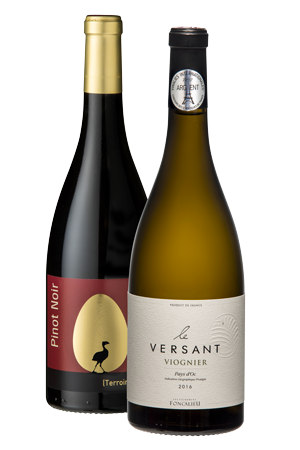Avoid a few mistakes to ensure you get the most out of the wines.
What temperature should the wines be served at?
The ideal serving temperature for a red wine is 17 °C. But this rule can change depending on the complexity of the wines.
When wine is served too cold, it reveals very little of its bouquet, due to the fact that the volatility of the aromas is trapped. Conversely, when the temperature is too high, it emphasises the alcohol (this is referred to as oxidation) or can destroy the aromas. The ideal serving temperature for a red wine is 17 °C. For more complex wines, it varies between 10 and 16 °C. For sweet and noble rot wines, serving at a low temperature will reduce the heavy feel caused by higher sugar content. As the wine warms up very quickly in the glass, it should be served preferably in small quantities and very often (count the equivalent of three sips), as per the sommeliers in the top restaurants.

What does it mean to serve a wine at room temperature?
Serving a wine at the right temperature (between 17 and 18°C) will help you avoid a few serving mistakes due to a misnomer. The expression ‘serve a wine at room temperature’, or ‘bring a wine up to room temperature’ is used for a serving temperature of between 17 and 18°C, well below present-day indoor temperatures, which range from 22 to 25°C. The expression refers to a custom that dates back to the 19th century, when the temperature in the room (the pantry of yesteryear) barely exceeded 17°C.
In what order should wines be served?
The classic order of serving a wine is to go from the lightest to the darkest: the starter and fish course pair with the whites, then come the rosé and red wines (between the main course and the cheese). For French-style meals, dishes are served from the mildest to most full-flavoured. The wine service follows the same pattern, from the youngest (with the lightest flavours) to the most mature. Noble rot wines are traditionally served with pudding for one simple reason: sugar saturates the taste buds, making it harder to drink anything else afterwards. But generally speaking, today’s meals are not as gargantuan as they used to be and trying to find the ideal food and wine pairing interferes with this order of service. So serving a dessert wine with a foie gras terrine starter may prove to be a wise choice, even though it makes returning to a simpler wine afterwards more challenging.
Choosing a glass: the right balance
Unfortunately, technique and aesthetics do not make good bedfellows when it comes to choosing a glass. Forget the Baccarat crystal service, avoid coloured glasses (red, green, etc.) and always choose the thinnest tasting glass possible… with a stem and bowl shape. The base should be wider and close in at the rim like a tulip, to allow the aromas to develop in the glass and then bring them into focus on the nose. This universal tulip shape, the marker of traditional tasting glasses known as ‘INAO’, remains the most versatile. As with the glass, the choice of decanter differs according to the type of wine. For red wines, as the wine should be in contact with as much air as possible, a decanter with a very wide bottom should be chosen. For whites, a narrower decanter is more practical: it can be placed in an ice bucket and thus kept cool.
Does a wine need decanting?
Wine is a living product that evolves over time and keeping it in a reductive environment often requires a supply of oxygen for it to open up and express its aromas. Decanting maximises the wine’s contact with oxygen. It is generally used for young wines (less than seven years old) or wines with little extraction, where no sediment has had time to form in the bottle.
When sediment has formed (especially in mature vintages), decanting is used to separate the sediment from the clear juice while airing the wine. Place a light source under the neck of the bottle (traditionally a candle) to light up the wine as it goes through the neck and prevent any sediment from being deposited in the decanter. Simply put, this is a way of filtering a wine without a filter, with the help of a light source.
What does it mean to serve a wine at room temperature?
Serving a wine at the right temperature (between 17 and 18°C) will help you avoid a few serving mistakes due to a misnomer. The expression ‘serve a wine at room temperature’, or ‘bring a wine up to room temperature’ is used for a serving temperature of between 17 and 18°C, well below present-day indoor temperatures, which range from 22 to 25°C. The expression refers to a custom that dates back to the 19th century, when the temperature in the room (the pantry of yesteryear) barely exceeded 17°C.
In what order should wines be served?
The classic order of serving a wine is to go from the lightest to the darkest: the starter and fish course pair with the whites, then come the rosé and red wines (between the main course and the cheese). For French-style meals, dishes are served from the mildest to most full-flavoured. The wine service follows the same pattern, from the youngest (with the lightest flavours) to the most mature. Noble rot wines are traditionally served with pudding for one simple reason: sugar saturates the taste buds, making it harder to drink anything else afterwards. But generally speaking, today’s meals are not as gargantuan as they used to be and trying to find the ideal food and wine pairing interferes with this order of service. So serving a dessert wine with a foie gras terrine starter may prove to be a wise choice, even though it makes returning to a simpler wine afterwards more challenging.
Choosing a glass: the right balance
Unfortunately, technique and aesthetics do not make good bedfellows when it comes to choosing a glass. Forget the Baccarat crystal service, avoid coloured glasses (red, green, etc.) and always choose the thinnest tasting glass possible… with a stem and bowl shape. The base should be wider and close in at the rim like a tulip, to allow the aromas to develop in the glass and then bring them into focus on the nose. This universal tulip shape, the marker of traditional tasting glasses known as ‘INAO’, remains the most versatile. As with the glass, the choice of decanter differs according to the type of wine. For red wines, as the wine should be in contact with as much air as possible, a decanter with a very wide bottom should be chosen. For whites, a narrower decanter is more practical: it can be placed in an ice bucket and thus kept cool.
Does a wine need decanting?
Wine is a living product that evolves over time and keeping it in a reductive environment often requires a supply of oxygen for it to open up and express its aromas. Decanting maximises the wine’s contact with oxygen. It is generally used for young wines (less than seven years old) or wines with little extraction, where no sediment has had time to form in the bottle.
When sediment has formed (especially in mature vintages), decanting is used to separate the sediment from the clear juice while airing the wine. Place a light source under the neck of the bottle (traditionally a candle) to light up the wine as it goes through the neck and prevent any sediment from being deposited in the decanter. Simply put, this is a way of filtering a wine without a filter, with the help of a light source.


